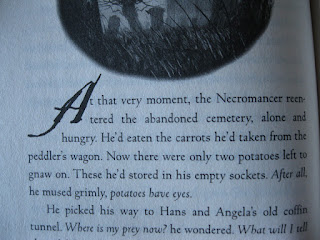Allan Stratton
 To begin on a positive note, this photograph contains, in my humble opinion, the best part of the book. Overall, I was not impressed with this book. My main problem is that the narrator has an adult voice, telling a children's story. Rather than being a part of a wild world of fantasy, the narrator is an adult telling an unrealistic story. The world is not real to him; therefore, it isn't real for me as a reader. Maybe it would come across differently for children; on the other hand, the intended audience is definitely older students. On the inside cover, it says "ages 10 up." There are many morbidly graphic events, like the Weevils taking the Necromancer to be dissected while alive.
To begin on a positive note, this photograph contains, in my humble opinion, the best part of the book. Overall, I was not impressed with this book. My main problem is that the narrator has an adult voice, telling a children's story. Rather than being a part of a wild world of fantasy, the narrator is an adult telling an unrealistic story. The world is not real to him; therefore, it isn't real for me as a reader. Maybe it would come across differently for children; on the other hand, the intended audience is definitely older students. On the inside cover, it says "ages 10 up." There are many morbidly graphic events, like the Weevils taking the Necromancer to be dissected while alive.
There were a plethora of Shakespeare allusions and rather direct references, as well as some almost word-for-word biblical quotations. These quotations were mainly used to parallel Peter the Hermit with God. When Gabriela and Hans wake up, expecting to be frozen to death, Hans asks Peter if he is God. On p. 247, Peter says to Hans, "I made you a promise: 'Wherever you are, fear not, for I am with you.'" On p.248, Peter says of Hans, "Behold, this is my beloved son, in whom I am well pleased." When Angela and her parents are to be burned at the stake, with Angela in the middle, it would not surprise me if this is an analogy to the crucifixion. One could probably make a fair case for Hans being paralleled with Christ: He sets out to fulfill the three prophecies, including "rising" out of a stone coffin. While Biblical allusions are certainly not excluded to writing that approves of Christianity, I can understand it in the context of quality literature. In the context of this story, the religious references just seem needless and disrespectful. On the other hand, this could be an easy tool for teaching students to identify Biblical allusions.
No comments:
Post a Comment